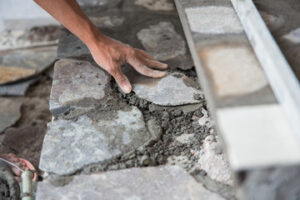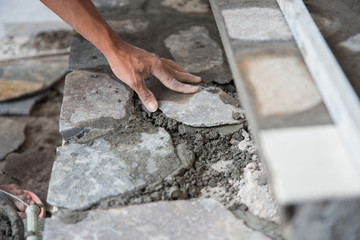Concrete is a strong material that can endure heavy traffic and weather conditions. It is essential to know how to build concrete stairs properly and safely.
Follow building codes and obtain any necessary permits for stair construction. Stair dimensions, safety features, and handrails are also crucial to consider. Keep reading the article below to learn more about Concrete Stair Installer.
Consider choosing precast steps, if possible. This will save you money on labor and installation costs.
Concrete stairs are a great addition to any home, offering both functionality and beauty. They can also increase the value of a property. They are highly durable and can withstand heavy traffic and weather. They are available in a variety of designs and colors and can be customized to suit the style of a house. However, they are expensive to install. Fortunately, there are some ways to reduce the cost of concrete stair installation.
The first step is to prepare the site where you want your new steps to be built. Begin by digging out the existing steps if necessary and then leveling the area. Next, remove the soil in the footprint of the new stairs. Then, fill the void with compactable gravel or sand and pack it down with a hand tamper. This will ensure that the new steps are level and will support their weight properly.
Once the area is prepared, you can begin the process of building your concrete stairs. Typically, you will want to hire a professional contractor to do the job for you. This will save you time and money in the long run.
When choosing a contractor, make sure that they are licensed and insured. They should also have experience in installing stairs. Additionally, ask for a free estimate before hiring them to work on your project. This will give you a better idea of how much the project is going to cost and will help you decide if it is worth the investment.
Another way to save money on a concrete stair installation is by replacing the existing steps instead of removing them and having new ones poured. This option is much less expensive and can still look nice. However, it is important to follow safety protocols when removing the old steps, such as wearing ear and eye protection and using a dust mask.
The final step before pouring your steps is to set up the form and reinforcement. This includes laying out footings that are 3 inches wider than the steps and cutting lengths of rebar 7 to 8 inches longer than the finished height of your new steps.
Formwork
The formwork is the structure that creates the shape of a poured concrete or rammed earth construction. It is composed of a series of boards, bolts, and other accessories that are assembled to support the concrete. In addition, it is also designed to transfer loads to the ground. The number and size of steel reinforcement bars used in the formwork is determined by a structural engineer and is based on the loads that are to be transferred.
The type of formwork used affects the final appearance of the concrete. If the concrete will be covered by cladding, this may not be an issue, but where the surface of the concrete is on show, it is important that the formwork produces a high quality finish. It is expensive to repair a surface that has been marred by poor formwork.
To prepare the formwork, builders must determine the dimensions and layout based on drawings and the site conditions. They must also cut and treat formwork panels and fabricate additional components as needed. Once the formwork is ready, it can be transported to the construction site. This minimizes project costs and time on-site, allowing builders to concentrate on other tasks.
Formwork can be made from wood, metal, or plastic. Some concrete structures, such as columns and piers, require permanent formwork. This type of formwork is often made from welded steel mesh, and it provides axial and shear reinforcement as well as confinement of the concrete. Other types of permanent formwork include fiber-reinforced plastic and prefabricated formwork.
When constructing stairs, it is important to make sure the formwork is square from one side to the other. This is done by measuring diagonally from one corner to the opposite corner and comparing that measurement. The formwork crew must also use a spirit level to ensure that the steps are plumb from one end to the other.
Once the formwork is in place, it is time to start pouring concrete. It is important to take the time to measure each step and calculate the unit rise and run, which are the individual heights of each step. This will help you to construct a staircase that is proportional to the existing house or structure.
Pouring
Concrete is durable and can withstand a lot of wear and tear. It also provides stability to stairs, making them safer to use. But it is important to note that there are many things to consider before you make the decision to install a concrete stair. This is why it is advisable to leave the installation of a concrete staircase to professionals, who are trained in handling heavy machinery and have the necessary knowledge of safety.
When you need to construct a set of concrete steps, it is best to go with a poured design rather than prefabricated stairs. The cost of a poured set is around $1,200 to $2,500, including materials and labor. Poured concrete is more versatile, allowing you to shape the steps to suit your preferences.
It is important to prepare the area before you begin working on your concrete step project. Begin by removing any existing steps and laying down a base. This will protect the new steps from shifts and deterioration. Once you have laid the base, dig a footing that is 3 inches wider than your new steps. This will allow for proper drainage and help prevent water pooling under the steps.
Once you have prepared the area, it is time to pour your concrete. Once the concrete is poured, let it dry for at least 24 hours before you start walking on it. This will give the concrete time to cure and become strong enough for regular use. If you want your steps to be even stronger, it is a good idea to add some reinforcement, such as 1/2-in. rebar.
A rebar cage will provide additional strength to the steps and will help prevent cracks in the future. You can either place the rebar on top of the concrete or run it through the formwork. Once the rebar is in place, cover it with a wire mesh to improve durability.
Once the concrete is cured, it is a good idea to seal the surface of your stairs. This will help to protect them from stains and prevent water from seeping into the concrete and weakening it. This is especially important if you live in an area with a lot of rain or snow.
Finishing
Concrete stairs are durable and long-lasting and can be a great addition to your home’s exterior. They are also easy to maintain and can withstand heavy loads. However, there are some things to keep in mind before installing concrete steps on your property.
First, it’s important to know that concrete is an expensive material to use for stairs. The price of the materials can vary depending on where you live, but the average cost for a set of concrete stairs is around $3,500. If you’re on a tight budget, there are several ways to reduce the cost of your concrete staircase project.
The most cost-effective way to install concrete stairs is by using a precast design. These stairs are manufactured in a factory and delivered to the construction site for installation. This saves time and money over pouring concrete on-site, as well as reducing the environmental impact. Precast concrete stairs are also a good choice for outdoor use, as they can withstand harsh weather conditions and are not affected by water.
To ensure a smooth finish on the concrete, it’s important to float and trowel the slab correctly. Inexpert troweling can trap air bubbles inside the concrete, preventing it from setting properly. In order to avoid this, you should always wear rubber gloves and kneel on boards when you are troweling the concrete. In addition, it’s important to use a large troweling tool, as this will make it easier to reach the center of larger slabs.
Once the concrete has set, it’s important to leave it alone for a few days so that it can cure. To prevent the concrete from drying out too quickly, you should sprinkle it or cover it with plastic to keep it moist. It’s also important to keep in mind that the concrete will take longer to cure if it’s colder than usual.
Once the concrete is cured, it’s time to finish the stairs. This step includes finishing the stair treads and cutting them to the correct size. It’s also important to clean the concrete before the finishing process to remove any dirt or debris. Once the stairs are finished, they can be painted to match your home’s exterior color scheme.


